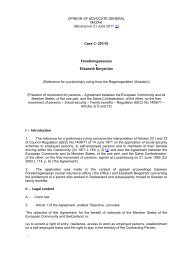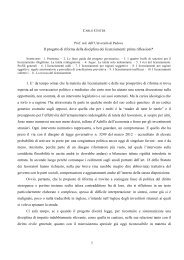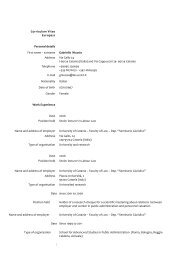Study on non-legislative initiatives for companies to promote gender ...
Study on non-legislative initiatives for companies to promote gender ...
Study on non-legislative initiatives for companies to promote gender ...
Create successful ePaper yourself
Turn your PDF publications into a flip-book with our unique Google optimized e-Paper software.
Gender equality <strong>initiatives</strong> 5<br />
In the framework of research studies, network activities and projects dealing with<br />
<strong>gender</strong> equality, sometimes <strong>on</strong>e of the outcomes is a compendium of good<br />
practices. This means that a number of enterprises which have an outstanding<br />
commitment in terms of <strong>gender</strong> equality in the workplace are presented in detail in a<br />
publicati<strong>on</strong> and/or <strong>on</strong> a website. The main reas<strong>on</strong> <strong>for</strong> providing such compendia is <strong>to</strong><br />
set examples <strong>for</strong> other enterprises and <strong>to</strong> share knowledge. Presenting good practices<br />
in terms of <strong>gender</strong> equality in the workplace have the potential <strong>to</strong> be an inspirati<strong>on</strong> <strong>for</strong><br />
other enterprises and workplaces. They may help <strong>to</strong> raise awareness and change<br />
social norms in order <strong>to</strong> minimise and/or eliminate <strong>gender</strong> inequalities. Frequently,<br />
compendia of good practices arise from competiti<strong>on</strong>s <strong>for</strong> prizes / awards, where good<br />
practices of winning or participating enterprises running <strong>for</strong> a prize / award are integrated<br />
in a publicati<strong>on</strong> or success s<strong>to</strong>ries are collected <strong>on</strong> a website.<br />
The largest group are compendia in the field of equal opportunities <strong>for</strong> women and men<br />
in general, including thematic issues such as recruitment, training and career<br />
opportunities, salary as well as combining work and private life, but there also exist<br />
compendia with a specific focus (e. g. “Ligeløn” (equal pay) in Denmark).<br />
What <strong>companies</strong> do <strong>to</strong> <strong>promote</strong> <strong>gender</strong> equality at the workplace<br />
How do <strong>companies</strong> address the various dimensi<strong>on</strong>s of <strong>gender</strong> equality more<br />
specifically? Multinati<strong>on</strong>al enterprises (MNE) adapt their strategies and approaches<br />
according <strong>to</strong> the <strong>legislative</strong> and cultural envir<strong>on</strong>ment of the country they are operating<br />
in. So, a MNE’s specific measures may vary from <strong>on</strong>e country <strong>to</strong> another. Also, while<br />
some of the company <strong>initiatives</strong> have a rather industry specific background, others<br />
appear <strong>to</strong> be more general and can easily be transferred across industries.<br />
The analysis has revealed the following seven fields of interventi<strong>on</strong>: recruitment,<br />
rec<strong>on</strong>ciliati<strong>on</strong>, retenti<strong>on</strong>, career opportunities, training, networking and communicati<strong>on</strong>.<br />
As multinati<strong>on</strong>al <strong>companies</strong> usually have in place rather comprehensive <strong>gender</strong><br />
equality or diversity strategies, which include measures <strong>for</strong> several if not all the fields<br />
menti<strong>on</strong>ed above, the strategies have been disaggregated in<strong>to</strong> their comp<strong>on</strong>ents <strong>to</strong><br />
allow <strong>for</strong> a structured analysis. A measure that is applied in a certain field by <strong>on</strong>e<br />
company can thereby also be taken up by another company and transferred <strong>to</strong> other<br />
fields (e. g. while <strong>on</strong>e company uses female role models <strong>to</strong> encourage applicati<strong>on</strong>s<br />
from women, the measure “role model” could, in principle, as well be applied by another<br />
company <strong>to</strong> <strong>promote</strong> career progressi<strong>on</strong> of women). The practices of the model<br />
<strong>companies</strong> can as well be an inspirati<strong>on</strong> <strong>for</strong> the designers and organisers of n<strong>on</strong><strong>legislative</strong><br />
<strong>initiatives</strong> when shaping their <strong>initiatives</strong>.<br />
Recruitment: In general, when recruiting, <strong>companies</strong> (have <strong>to</strong>) <strong>for</strong>mulate their job<br />
advertisements in a way <strong>to</strong> attract both men and women. Nevertheless, there are ways<br />
<strong>to</strong> positively influence applicati<strong>on</strong>s by the <strong>gender</strong> that is underrepresented in a<br />
company’s employment structure. On the <strong>on</strong>e hand, such <strong>gender</strong> biases often exist in<br />
certain industries and especially <strong>companies</strong> that are active in technology oriented<br />
sec<strong>to</strong>rs have elaborated ways <strong>to</strong> attract more women (while <strong>companies</strong> in e. g. the<br />
cosmetics industry are working <strong>on</strong> raising their share of male employees). On the other<br />
hand, a bias may also occur within <strong>on</strong>e company in different job positi<strong>on</strong>s (e. g. when<br />
women tend <strong>to</strong> work in administrative jobs and men in producti<strong>on</strong>) or in different<br />
hierarchical levels. Many of the enterprises c<strong>on</strong>sidered in this study have implemented<br />
procedures <strong>to</strong> attract and employ more women in order <strong>to</strong> achieve a better balanced<br />
staff structure and <strong>to</strong> benefit from the diverse talents and skills. The <strong>initiatives</strong> and<br />
measures go bey<strong>on</strong>d quotas and range from simple <strong>to</strong> more sophisticated procedures.
















